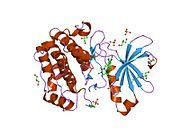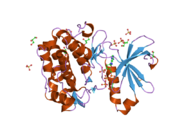Phosphoinositide-dependent kinase-1
Ensembl | |||||||||
|---|---|---|---|---|---|---|---|---|---|
| UniProt | |||||||||
| RefSeq (mRNA) | |||||||||
| RefSeq (protein) | |||||||||
| Location (UCSC) | Chr 16: 2.54 – 2.6 Mb | Chr 17: 24.29 – 24.37 Mb | |||||||
| PubMed search | [3] | [4] | |||||||
| View/Edit Human | View/Edit Mouse |
In the field of biochemistry, PDPK1 refers to the protein 3-phosphoinositide-dependent protein kinase-1, an enzyme which is encoded by the PDPK1 gene in humans.[5] It is implicated in the development and progression of melanomas.[6]
Function
PDPK1 is a master
Mice lacking PDPK1 die during early embryonic development, indicating that this enzyme is critical for transmitting the growth-promoting signals necessary for normal mammalian development.
Mice that are deficient in PDPK1 have a ≈40% decrease in body mass, mild glucose intolerance, and are resistant to cancer brought about by hyperactivation of the PI3K pathway (PTEN+/-).[7] [8]
Plant PDK1 plays an important role in regulating PIN-mediated auxin transport, and is thus involved in various developmental processes, such as embryonic development, lateral root formation, vasculature patterning, apical hook formation, gravitropism and phototropism.[9]
Etymology
PDPK1 stands for 3-phosphoinositide-dependent protein kinase 1. PDPK1 functions downstream of
Structure
The structure of PDPK1 can be divided into two domains; the kinase or catalytic domain and the
The kinase domain has three ligand binding sites; the substrate binding site, the ATP binding site, and the docking site (also known as PIF pocket). Several PDPK1 substrates including S6K and Protein kinase C, require the binding at this docking site. Small molecule allosteric activators of PDPK1 were shown to selectively inhibit activation of substrates that require docking site interaction. These compounds do not bind to the active site and allow PDPK1 to activate other substrates that do not require docking site interaction. PDPK1 is constitutively active and at present, there is no known inhibitor proteins for PDPK1.
The activation of PDPK1's main effector, AKT, is believed to require a proper orientation of the kinase and PH domains of PDPK1 and AKT at the membrane.
Interactions
Phosphoinositide-dependent kinase-1 has been shown to
References
- ^ a b c GRCh38: Ensembl release 89: ENSG00000140992 – Ensembl, May 2017
- ^ a b c GRCm38: Ensembl release 89: ENSMUSG00000024122 – Ensembl, May 2017
- ^ "Human PubMed Reference:". National Center for Biotechnology Information, U.S. National Library of Medicine.
- ^ "Mouse PubMed Reference:". National Center for Biotechnology Information, U.S. National Library of Medicine.
- ^ "Entrez Gene: PDPK1".
- PMID 24037523.
- PMID 15209375.
- PMID 12374740.
- S2CID 218593545.
- PMID 11825911.
- PMID 11313365.
- ^ PMID 11781095.
- ^ PMID 10764742.
- PMID 10698939.
- ^ PMID 10357815.
- PMID 9748166.
- ^ PMID 12387817.
- PMID 12177059.
Further reading
- Vanhaesebroeck B, Alessi DR (2000). "The PI3K-PDK1 connection: more than just a road to PKB". Biochem. J. 346 Pt 3 (3): 561–76. PMID 10698680.
- Maruyama K, Sugano S (1994). "Oligo-capping: a simple method to replace the cap structure of eukaryotic mRNAs with oligoribonucleotides". Gene. 138 (1–2): 171–4. PMID 8125298.
- Alessi DR, James SR, Downes CP, Holmes AB, Gaffney PR, Reese CB, Cohen P (1997). "Characterization of a 3-phosphoinositide-dependent protein kinase which phosphorylates and activates protein kinase Balpha". Curr. Biol. 7 (4): 261–9. S2CID 2094414.
- Moser BA, Dennis PB, Pullen N, Pearson RB, Williamson NA, Wettenhall RE, Kozma SC, Thomas G (1997). "Dual requirement for a newly identified phosphorylation site in p70s6k". Mol. Cell. Biol. 17 (9): 5648–55. PMID 9271440.
- Alessi DR, Deak M, Casamayor A, Caudwell FB, Morrice N, Norman DG, Gaffney P, Reese CB, MacDougall CN, Harbison D, Ashworth A, Bownes M (1997). "3-Phosphoinositide-dependent protein kinase-1 (PDK1): structural and functional homology with the Drosophila DSTPK61 kinase". Curr. Biol. 7 (10): 776–89. S2CID 1167390.
- Suzuki Y, Yoshitomo-Nakagawa K, Maruyama K, Suyama A, Sugano S (1997). "Construction and characterization of a full length-enriched and a 5'-end-enriched cDNA library". Gene. 200 (1–2): 149–56. PMID 9373149.
- Meier R, Alessi DR, Cron P, Andjelković M, Hemmings BA (1997). "Mitogenic activation, phosphorylation, and nuclear translocation of protein kinase Bbeta". J. Biol. Chem. 272 (48): 30491–7. PMID 9374542.
- Alessi DR, Kozlowski MT, Weng QP, Morrice N, Avruch J (1998). "3-Phosphoinositide-dependent protein kinase 1 (PDK1) phosphorylates and activates the p70 S6 kinase in vivo and in vitro" (PDF). Curr. Biol. 8 (2): 69–81. S2CID 18688785.

- Dalby KN, Morrice N, Caudwell FB, Avruch J, Cohen P (1998). "Identification of regulatory phosphorylation sites in mitogen-activated protein kinase (MAPK)-activated protein kinase-1a/p90rsk that are inducible by MAPK". J. Biol. Chem. 273 (3): 1496–505. PMID 9430688.
- Pullen N, Dennis PB, Andjelkovic M, Dufner A, Kozma SC, Hemmings BA, Thomas G (1998). "Phosphorylation and activation of p70s6k by PDK1". Science. 279 (5351): 707–10. PMID 9445476.
- Stephens L, Anderson K, Stokoe D, Erdjument-Bromage H, Painter GF, Holmes AB, Gaffney PR, Reese CB, McCormick F, Tempst P, Coadwell J, Hawkins PT (1998). "Protein kinase B kinases that mediate phosphatidylinositol 3,4,5-trisphosphate-dependent activation of protein kinase B". Science. 279 (5351): 710–4. PMID 9445477.
- Walker KS, Deak M, Paterson A, Hudson K, Cohen P, Alessi DR (1998). "Activation of protein kinase B beta and gamma isoforms by insulin in vivo and by 3-phosphoinositide-dependent protein kinase-1 in vitro: comparison with protein kinase B alpha". Biochem. J. 331 ( Pt 1) (1): 299–308. PMID 9512493.
- Anderson KE, Coadwell J, Stephens LR, Hawkins PT (1998). "Translocation of PDK-1 to the plasma membrane is important in allowing PDK-1 to activate protein kinase B". Curr. Biol. 8 (12): 684–91. S2CID 13936854.
- Le Good JA, Ziegler WH, Parekh DB, Alessi DR, Cohen P, Parker PJ (1998). "Protein kinase C isotypes controlled by phosphoinositide 3-kinase through the protein kinase PDK1". Science. 281 (5385): 2042–5. PMID 9748166.
- Currie RA, Walker KS, Gray A, Deak M, Casamayor A, Downes CP, Cohen P, Alessi DR, Lucocq J (1999). "Role of phosphatidylinositol 3,4,5-trisphosphate in regulating the activity and localization of 3-phosphoinositide-dependent protein kinase-1". Biochem. J. 337 ( Pt 3) (3): 575–83. PMID 9895304.
- Kobayashi T, Cohen P (1999). "Activation of serum- and glucocorticoid-regulated protein kinase by agonists that activate phosphatidylinositide 3-kinase is mediated by 3-phosphoinositide-dependent protein kinase-1 (PDK1) and PDK2". Biochem. J. 339 ( Pt 2) (2): 319–28. PMID 10191262.
- Balendran A, Casamayor A, Deak M, Paterson A, Gaffney P, Currie R, Downes CP, Alessi DR (1999). "PDK1 acquires PDK2 activity in the presence of a synthetic peptide derived from the carboxyl terminus of PRK2". Curr. Biol. 9 (8): 393–404. S2CID 16473977.
- Park J, Leong ML, Buse P, Maiyar AC, Firestone GL, Hemmings BA (1999). "Serum and glucocorticoid-inducible kinase (SGK) is a target of the PI 3-kinase-stimulated signaling pathway". EMBO J. 18 (11): 3024–33. PMID 10357815.
- Paradis S, Ailion M, Toker A, Thomas JH, Ruvkun G (1999). "A PDK1 homolog is necessary and sufficient to transduce AGE-1 PI3 kinase signals that regulate diapause in Caenorhabditis elegans". Genes Dev. 13 (11): 1438–52. PMID 10364160.
- Casamayor A, Morrice NA, Alessi DR (1999). "Phosphorylation of Ser-241 is essential for the activity of 3-phosphoinositide-dependent protein kinase-1: identification of five sites of phosphorylation in vivo". Biochem. J. 342 ( Pt 2) (2): 287–92. PMID 10455013.
External links
- 3-phosphoinositide-dependent+protein+kinase at the U.S. National Library of Medicine Medical Subject Headings (MeSH)












![1z5m: Crystal Structure Of N1-[3-[[5-bromo-2-[[3-[(1-pyrrolidinylcarbonyl)amino]phenyl]amino]-4-pyrimidinyl]amino]propyl]-2,2-dimethylpropanediamide Complexed with Human PDK1](http://upload.wikimedia.org/wikipedia/commons/thumb/7/7f/PDB_1z5m_EBI.jpg/180px-PDB_1z5m_EBI.jpg)
